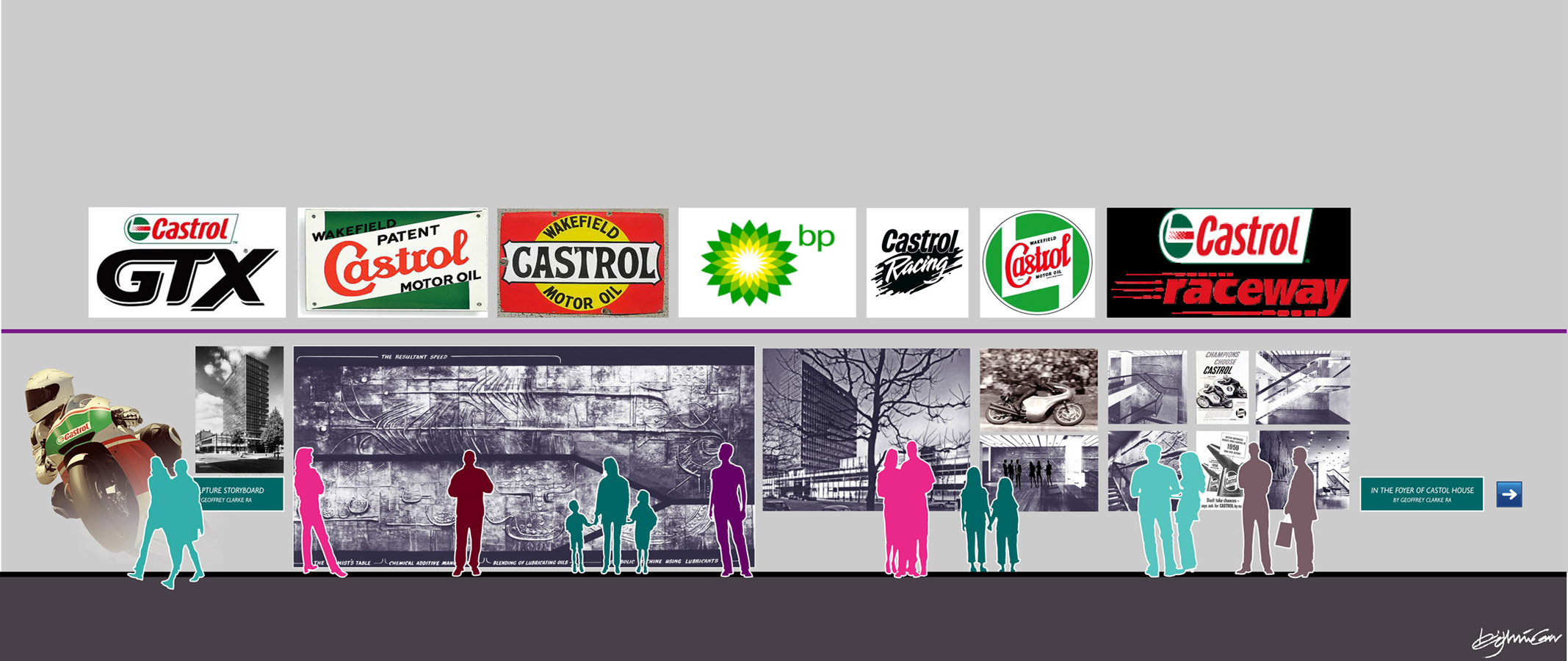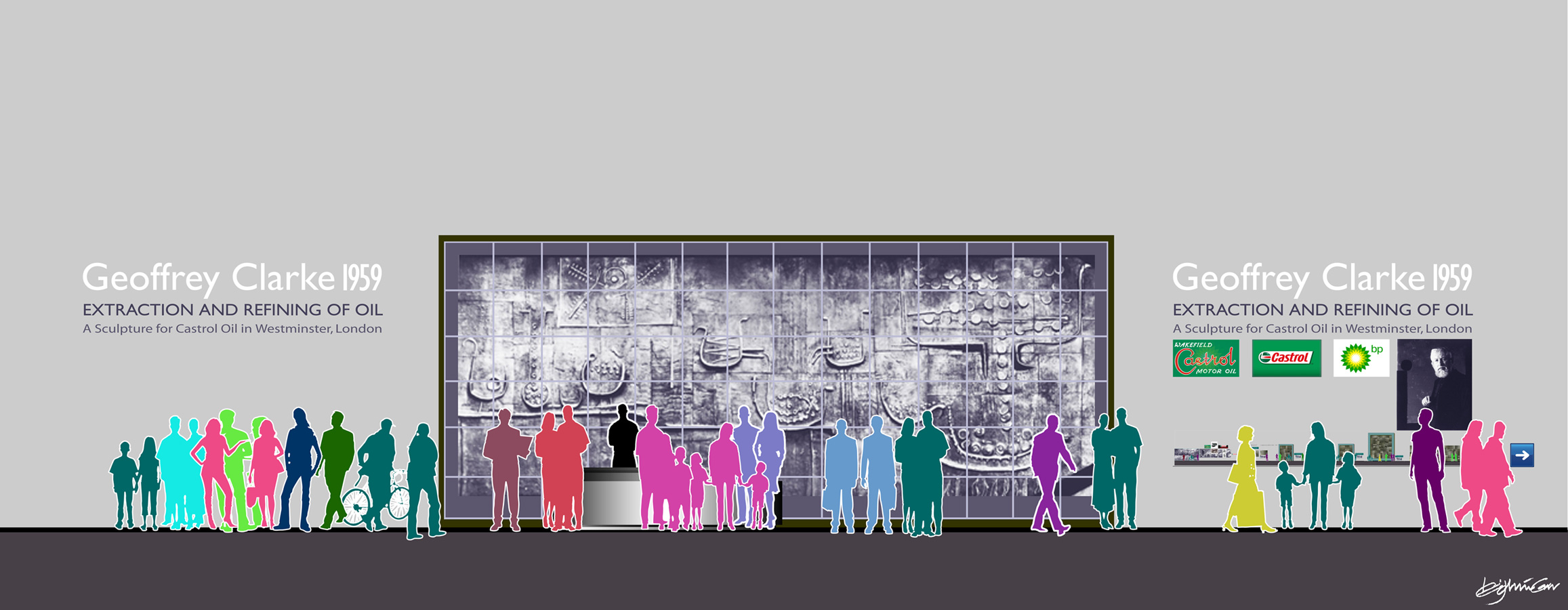| \r\n\r\n |
\r\n\r\n |
\r\n\r\n |
\r\n\r\n |
\r\n\r\n |
\r\n
.. an eclectic folio of words and images
Following on from yesterday’s image of the Geoffrey Clarke Exhibition Entrance, today’s is the transition wall, the introduction to Charles Cheers Wakefield and the birth of the Castrol brand.\r\n\r\nIn the late 19th century Charles Wakefield was working for Vacuum Oils Limited selling lubricants for heavy machinery. In 1899 he left to form his own oil company C C Wakefield Limited in Cheapside, London. Wakefield was a visionary and even at the beginning of the 20th century he saw that Automobiles and Aeroplanes would be the future of transport, and they would need lubricant oils. These oils would need sufficient liquidity to start working when cold but enough stability to work in extreme heat. Castrol was created, from mixtures of lubricants and Caster Oil taken from the Caster bean.\r\n\r\nBy the 1950s, when the new HQ Castrol House was commissioned, Castrol was synonymous with land speed records, motor racing and Honda superbikes.\r\n\r\n \r\n\r\n \r\n
\r\n\r\n \r\n
| \r\n\r\n |
\r\n\r\n |
\r\n\r\n |
\r\n\r\n |
\r\n\r\n |
It’s been many years in the making (!) but here’s the concept proposal for the entrance to the exhibition of Geoffrey Clarke’s ‘Extraction and Refining of Oil’ – his 1959 cast aluminium frieze covering 1,000 square feet of Castol’s HQ foyer.\r\n\r\n \r\n\r\n \r\n
\r\n\r\n \r\n
| \r\n\r\n |
\r\n\r\n |
\r\n\r\n |
\r\n\r\n |
\r\n\r\n |
\r\n \r\n\r\n
I’m trying to work out whether to loan some pieces of my sculpture to a gallery and in the course of my research I read the webpage on the Board of Trustees at the…
I’m trying to work out whether to loan out some pieces of my sculpture to a gallery and in the course of my research I read the webpage on the Board of Trustees at the Tate. The text outlines the purpose of the board and the role of an individual board member.\r\n\r\nIt’s strangely heart warming to see a public body spell out clearly that a trustee cannot use their position for personal gain, nor ‘seek to use the opportunity of public service to promote their private interests’.\r\n\r\nBut best of all was the list of ‘Seven Principles of Public Life’ drawn up by the Nolan Committee at the end of their short report in May 1995. They are worth serious reflection.\r\n\r\nThe seven principles are:\r\n\r\nSelflessness\r\n\r\nHolders of the public office should take decisions solely in line with the public interest. They should not do so in order to gain financial or other material benefits for themselves, their family, or their friends.\r\n\r\nIntegrity\r\n\r\nHolders of public office should not place themselves under any financial or other obligation to outside individuals or organizations that might influence them in the performance of their official duties.\r\n\r\nObjectivity\r\n\r\nIn carrying out public business, including making public appointments, awarding contracts, or recommending individuals for rewards and benefits, holders of public office should make choices on merit.\r\n\r\nAccountability\r\n\r\nHolders of public office are accountable for their decisions and actions to the public and must submit themselves to whatever scrutiny is appropriate to their office.\r\n\r\nOpenness\r\n\r\nHolders of public office should be as open as possible about all the decisions and actions they take. They should give reasons for their decisions and restrict information only when the wider public interest clearly demands it.\r\n\r\nHonesty\r\n\r\nHolders of public office have a duty to declare any private interests relating to their public duties and to take steps to resolve any conflicts arising in any way that protects the public interest.\r\n\r\nLeadership\r\n\r\nHolders of public office should promote and support these principles by leadership and example.
There is an old jewish saying:\r\n\r\neveryone should carry a piece of paper in each pocket of their coat. On one piece is written:\r\n\r\nYou are nothing but one of millions upon millions of grains of sand in the universe,\r\n\r\nIn the other pocket the piece of paper says:\r\n\r\nI made the universe just for you.
For those with about 11 minutes to spare and an interest in business modelling, this video is interesting on two levels.\r\n\r\nFirst, for it’s own sake – the content is ok. But second – and more interesting to me at the moment – the video itself is a good example of how web based media can be used to promote ideas. I’m wondering how I can use this approach … I need a project to prototype\r\n\r\n
I Imagine …\n\nA church where people proudly own the name Christian outside its walls\nand proudly act as Christians inside its walls\n\nWhere people proudly give as Christians should\nand proudly serve as Christians should\n\nA church that is not\nawash with mediocrity\nor with sameness done well\n\nA church that does not\nreward competence in mediocre service\nand punish outrageous but courageous failure\n\nBut a church where courage\nand enterprise\nare second nature\n\nAnd the greatest aspiration\ncollectively and personally\nis to serve God\nin the world\nwith all the pride\nand confidence\nof those who live as children of the King.